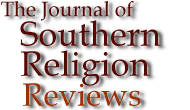

John W. Quist, Restless Visionaries: The Social Roots of Antebellum Reform in Alabama and Michigan. Baton Rouge: Louisiana State University Press, 1998. 562 pp.
![]()
![]()
![]()
In Restless Visionaries, John W. Quist, assistant professor of history at Shippensburg University of Pennsylvania, has written an important and challenging work of historical scholarship. As a comprehensive account of antebellum reform in Tuscaloosa County, Alabama and Washtenaw County, Michigan, Quist’s findings have serious implications for the study of reform and religion in antebellum America. Understanding that these two places were not necessarily representative of their regions, Quist remains modest, perhaps unduly so, about the wider applicability of his conclusions. The thesis of Restless Visionaries is that "a largely similar climate of reform" (p. 7) existed in the north and south. Taking issue with historian John Kuykendall, Quist argues that slavery did not significantly interfere with southern enthusiasm for most reforms, that "both abolitionists and slaveholders endorsed benevolence itself," (p. 153) and that southern philanthropy was not a backwater of a mainly northern mainstream of antebellum reform.
| "Despite [its] imperfections, Restless Visionaries succeeds admirably in making its point--that a relatively dynamic climate of reform existed in the antebellum South, which mirrored reformism in the northern states." | |
Restless Visionaries deals topically with three realms of reform--tract distribution and Sunday schools, temperance, and slavery-related issues--in each county. In every case, the author discusses Tuscaloosa County first because he thinks scholars have studied southern benevolence less intensively and that they have often underestimated its regional importance. No mere reductionist, Quist gives ample attention to differences between the counties. Compared to their Alabama counterparts, for example, citizens of Washtenaw County experienced greater religious diversity, responded more positively to abolitionism, accepted female activists, and tolerated radical social experimentation (such as Fourierism). Tuscaloosa County reformers, on the other hand, more openly embraced colonization and missions to the slaves. Quist then goes on to document pervasive interregional similarities among reformers. In both places, advocates of social reform tended to be relatively prosperous and to put great store in education. National benevolent organizations operated in both places, and their followers often had like characteristics. Both in Alabama and Michigan, for example, members of the Sons of Temperance tended to be less wealthy and less connected to churches than were other reformers. Whigs, who avidly supported the market economy, were numerous in both counties and tended to embrace benevolent reform more avidly than did Democrats. In many reform movements, whether in Alabama or Michigan, disproportionate numbers of Presbyterians and townspeople participated. Linked to the fortunes of the economy, Tuscaloosa and Washtenaw reform organizations both experienced cycles of success and failure.
Quist writes in a fairly accessible style, but the detail and complexity of Restless Visionaries will drive away many casual readers. Engaged scholars of southern religion will nevertheless appreciate Quist’s achievement. What he loses in breadth by focusing on two counties, the author gains in depth of documentation and analysis. Indeed, Quist thoughtfully examines so many sources (census records, state court documents, church records, manuscript collections, and more than seventy different newspapers) that historians interested in empirical evidence will give his book thoughtful consideration. Not content merely to discuss the activities of benevolent societies, Quist carefully scrutinizes their membership, teasing out information on age, wealth, political party, and religious affiliation. Readers can scan much of this data in the text; the statistical enthusiast will find the thirty-four appendices of interest.
Some sections of Restless Visionaries are more impressive than others. Quist appears to have researched and thought through the first four chapters, which deal with tracts, Sunday schools, and temperance, in especially impressive fashion. But the author’s discussions of slavery-related issues, and in particular his analysis of missions to the slaves, are less nuanced and less complete. Because southern philanthropists seldom aimed their efforts at African-Americans, Quist does little to detail the concerns of the slave population. And only for slave missions does Quist depict social control as the primary motivation for benevolent outreach. Quist may also understate how much slavery restrained reform impulses in the South. He proves that a strong temperance movement existed in Alabama but also shows that, unlike Michigan, it never adopted state prohibition. The determination to defend slavery and the related fear of government regulation probably explain this outcome more than Quist admits. Despite such imperfections, Restless Visionaries succeeds admirably in making its point--that a relatively dynamic climate of reform existed in the antebellum South, which mirrored reformism in the northern states. If it does nothing else, this book should definitively put to rest the notion that white southerners, as citizens and church members, had little interest in organized efforts to ameliorate social problems.
Christopher H. Owen, Northeastern State University
© 1998-99 by The Journal of Southern Religion. All rights reserved.
ISSN 1094-5234